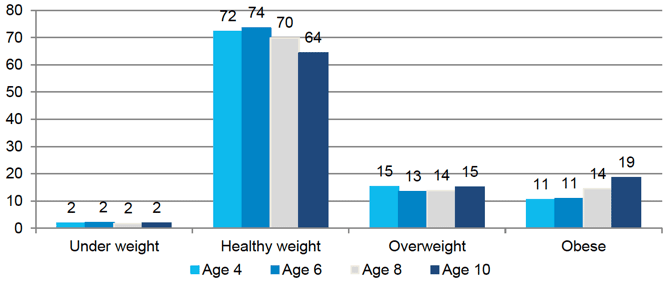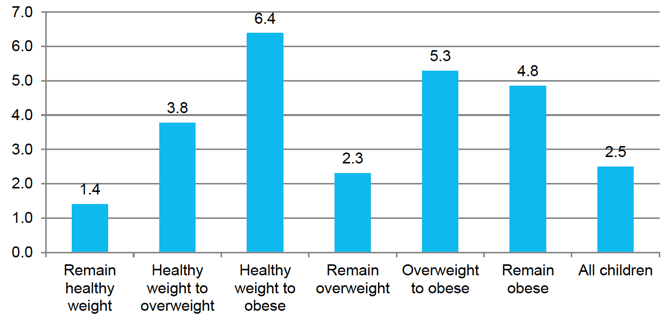Growing up in Scotland: overweight and obesity at age 10
The report uses data from the Growing Up in Scotland study to investigate trajectories of overweight and obesity during the primary school years and identify key risk factors.
3. Overweight and obesity at ages 4, 6, 8 and 10
3.1. Introduction
As discussed in the introductory chapter, levels of overweight and obesity among children have become of increasing concern in recent years, particularly in Scotland. One of the key questions we wish to examine is how levels progress with increasing age. Of particular interest, and something which can only be addressed using longitudinal data, which in Scotland realistically means data from the Growing Up in Scotland study, is movement into or out of overweight and obesity.
This chapter will look at the proportion of children who are identified as overweight and obese at ages 4, 6, 8 and 10, as well as the proportions of children moving into and out of overweight and obese between the ages of 6 and 10.
3.2. Key findings
- Levels of overweight and obesity increase with age. At age 6, 24% of children were overweight including 11% who were obese. By age 10, 34% of children were overweight including 19% who were obese. On average, BMI had increased by 2.5 for all children.
- Most (79%) children who were a healthy weight at age 6 remained a healthy weight at age 10. However, around 12% became overweight and a further 8% became obese.
- Children already overweight or obese at age 6 were more likely to remain so or see their BMI increase over the primary school period than to show a reduction in their BMI. Amongst children who were overweight at age 6, 34% remained overweight and 33% became obese. Around 34% returned to a healthy weight.
- For children who were obese at age 6, the vast majority (79%) remained so. Thirteen percent became overweight and just 8% became a healthy weight.
- Even amongst those children who remained in the same BMI category at both ages, increases in BMI are evident. For children who remained a healthy weight, BMI increased by an average of 1.4 points. For those who were overweight and those were obese at both time points BMI increased by 2.3 and 4.8 points respectively.
3.3. Prevalence of overweight and obesity
Figure 3‑1 illustrates the proportion of children categorised as underweight, healthy weight, overweight and obese at ages 4, 6, 8 and 10 years.
As the graph shows, levels of overweight and obesity clearly and significantly increase with age. At age 6, 24% of children were overweight including 11% who were obese. By age 10, 34% of children were overweight including 19% who were obese. The proportion of children who were a healthy weight correspondingly decreased over the same period from 74% at age 6 to 64% at age 10.
Figure 3‑1 Children's BMI classification by age

Unweighted bases: Age 4 – 3676; Age 6 - 2710; Age 8 - 2752; Age 10 – 2754
3.4. Change in overweight and obesity
Change in BMI between ages 6 and 10 is considered in two ways: first, in relation to the extent to which children move between BMI classifications; second in relation to mean change in BMI score for children who remain in or move between different classifications over time.
3.4.1. Change in BMI classification
The change in children's BMI classifications between ages 6 and 10 are illustrated in Table 3‑1 and Table 3‑2.
Taking children's BMI at age 6 as a starting point, the data in Table 3‑1 show that the majority of children (79%) who were obese at age 6 were also obese at age 10. The remainder showed a decrease in BMI over time with 13% reducing to overweight and 8% to a healthy weight. Children who were overweight at age 6 were more likely to remain overweight or to move into the obese category than to show a drop in BMI: 34% moved to healthy weight whilst 34% showed no change and 33% moved into the obese category. Most children (67%) who were underweight at age 6 were a healthy weight at age 10.
The results are broadly comparable with similar UK research. For example, analysis of data from the Millennium Cohort Study showed that the proportion of healthy, overweight and obese 5 year olds becoming or remaining obese by age 11 were 6%, 32% and 68% respectively (Mead et al, 2016). Comparative figures from analysis of administrative data from the National Child Measurement Programme (NCMP)[13] in England were 8%, 43% and 77% (Copley et al, 2017).
Table 3‑1 Children's BMI classification at age 10 by BMI classification at age 6
| BMI Age 6 | ||||
|---|---|---|---|---|
| Underweight | Healthy weight | Overweight | Obese | |
| % | % | % | % | |
| BMI Age 10 | ||||
| Underweight | 29 | 2 | - | - |
| Healthy weight | 67 | 79 | 34 | 8 |
| Overweight | - | 12 | 34 | 13 |
| Obese | 4 | 8 | 33 | 79 |
| Unweighted bases | 51 | 1977 | 366 | 263 |
Starting with BMI classification at age 10 (Table 3‑2), the results show that the majority of children who were obese at age 10 were already overweight or obese at age 6. For example 46% of obese children at age 10 were also obese at age 6 whilst 24% had increased from being overweight at age 6 and 30% from being a healthy weight. Children who were overweight (not obese) at age 10 had mostly (61%) been a healthy weight at age 6 whilst some (30%) had already been overweight. A small proportion (9%) had reduced their BMI from obese.
The most consistent group was those who were a healthy weight at age 10 – 90% had also been a healthy weight at age 6. Meanwhile those underweight at age 10 had mostly lowered their BMI since age 6 – 67% having been a healthy weight at that age.
Table 3‑2 Children's BMI classification at age 6 by BMI classification at age 10
| BMI Age 10 | ||||
|---|---|---|---|---|
| Underweight | Healthy weight | Overweight | Obese | |
| % | % | % | % | |
| BMI Age 6 | ||||
| Underweight | 33 | 2 | - | <1 |
| Healthy weight | 67 | 90 | 61 | 30 |
| Overweight | - | 7 | 30 | 24 |
| Obese | - | 1 | 9 | 46 |
| Unweighted bases | 47 | 1758 | 391 | 461 |
Bases and source information go here.
3.4.2. Mean changes in BMI
Examining change through use of BMI classifications can mask underlying changes in BMI, particularly for those children who remain within the same classification at both ages. Furthermore, some children may change classification via a relatively small increase in their BMI score.
To explore this variation further, children whose BMI had increased so that they moved category and those who BMI category remained the same were placed in the following groups according to their BMI status at ages 6 and 10[14]:
- Remain healthy weight
- Move from healthy weight to overweight
- Move from healthy weight to obese
- Remain overweight
- Move from overweight to obese
- Remain obese
The mean change in BMI for children in each category is shown in Figure 3‑2.
Figure 3‑2 Mean change in BMI by change in BMI classification between ages 6 and 10

Between the ages of 6 and 10, BMI increased by an average of 2.5 for all children. As may be expected, the largest changes are observed amongst those children who move into overweight or obese categories. For example, children who move from a healthy weight to obese record an average BMI change of 6.4 whilst those who move from overweight to obese show an average change of 5.3. Notably, even amongst those children who remain in the same category, increases are evident. In particular, children who are obese at both time points show an average BMI increase of 4.8.
Contact
Email: Ewan Patterson
There is a problem
Thanks for your feedback